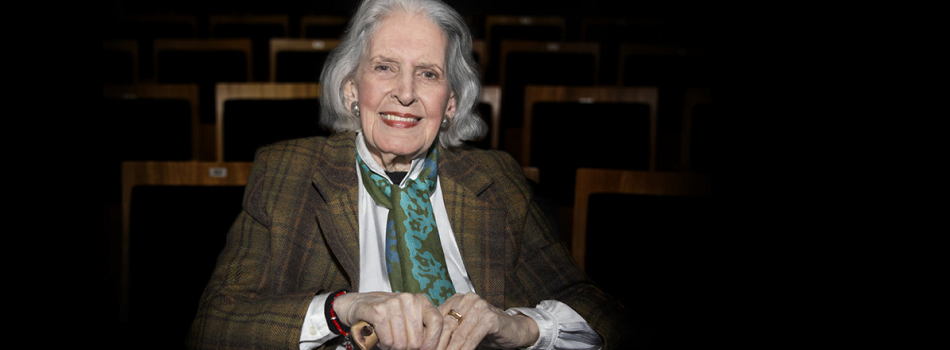Lygia Fagundes Telles: one of Brazil’s most important writers among USP’s alumni
(by Filipe Albessu Narciso) – June 17th, 2021
Born in the city of São Paulo in 1923, Lygia Fagundes Telles is recognized as one of the most influential writers of Brazilian literature. Winner of national and international literary prizes and founder of the Brazilian Union of Writers (UBE), her works have been translated into English, French, Spanish, German, Swedish, Italian among other languages. She graduated from USP, where she developed important friendships and acquired knowledge that may have helped her become such a renowned personality. Learn more about her in the article.

Lygia Fagundes da Silva Telles is a Brazilian writer who was born in 1923. At the age of 98, Lygia is considered by some the most important Brazilian female writer alive. She is also a major personality among USP’s alumni, with a life story that has strong ties to the university.
Acting professionally as a lawyer and writer, she has won many national literary prizes, such as the well known Jabuti prize four times. Internationally, she won the Portuguese prize Camões in 2005, an expression of her recognition among Portuguese speakers worldwide and, in 2016, she became the first Brazilian female writer nominated for the Nobel Literature Prize. Lygia is also one of the founders of the Brazilian Union of Writers (UBE) and a former-president of the Cinemateca Brasileira, an institution that is responsible for the preservation of Brazilian cinematographic production. Her works have been translated into English, French, Spanish, German, Swedish, Italian among other languages.
Lygia was born in the city of São Paulo, but spent most of her childhood in the countryside of São Paulo state. When she was eight years old, her family moved to Rio de Janeiro, where she lived for five years before coming back to São Paulo. Even in those early stages of her life, Lygia’s interest in literature and linguistics had always accompanied her, to the point that she released her first book when she was only fifteen.
In 1939, she joined USP’s School of Physical Education and Sports. She also began participating in literary debates, in which she met Oswald and Mário de Andrade, two well known Brazilian writers. In the same period, she started writing for newspapers and engaged in activities at the university’s Languages Faculty.
Two years later, she enrolled at USP’s Faculty of Law. Her father, who also graduated from USP’s Faculty of Law, served as inspiration for her to become a lawyer. In an interview to the Brazilian newspaper O Estado de São Paulo, Lygia pointed out that she was one of only six women in a class of over a hundred students. There, she met poetist and writer Hilda Hilst, who would become a dear friend for many years to come. In 1944, while still an undergraduate student, she published her second short stories book.
Her third book would only come out five years later. The title, O Cacto Vermelho (The Red Cactus), received the Afonso Arinos Prize, given out by the Brazilian Academy of Letters. Up to this point, Lygia hadn’t published a single novel. Ciranda de Pedra, published in English as The Marble Dance many years later, would be released in 1954, being a major production on her ascension to national recognition. Acclaimed by many Brazilian literary critics, the story is critical of bourgeois expectations and traditions surrounding women.
From this point on, Lygia’s literary maturity would make her responsible for a number of well known and acclaimed books. Her second novel, Verão no Aquário (1963) whose title may be translated as Summer in the Aquarius, also won the Jabuti prize.
In 1964, Brazil suffered a military coup that lasted for 21 years. It was under this regime, in the seventies, that Lygia wrote some of her most well-known productions and obtained international recognition. Her short story book called Antes do Baile Verde (1970), roughly translated as Before the Green Ball, was awarded a prize in France. Three years later, she released her novel As Meninas (1973), which was published in New York in 1982 under the title The Girl in the Photograph.
In 1975, she started a project to create a museum of Brazilian literature, though the initiative would fall through two years later. That’s because 1977 was a turbulent year for Telles. With the death of her husband, the movie critic and USP alumnus Paulo Emílio Salles Gomes, she became president of Cinemateca Brasileira. She then donated more than two hundred collected documents that would integrate the museum’s collection to USP’s Institute of Brazilian Studies. Also in 1977, she participated in a large protest with other intellectuals against censorship and authoritarian acts of the dictatorship.
It was in 1985 that Lygia was elected to a chair at the Brazilian Academy of Letters, one of the most honorable achievements a Brazilian writer can be granted. She had already written three novels, six short story books and a memoir. Two years later, she was only the third woman to be inaugurated as a part of the institution, occupying the sixteenth chair out of forty. Being already 64 years old at the time, she still had much to write, publishing a novel, another memoir and some short story books for the next couple of years. Today, her personal collection is under the ward of Instituto Moreira Salles, a cultural center and extension Institute founded in the nineties by Walther Moreira Salles, another USP’s Faculty of Law alumnus.
